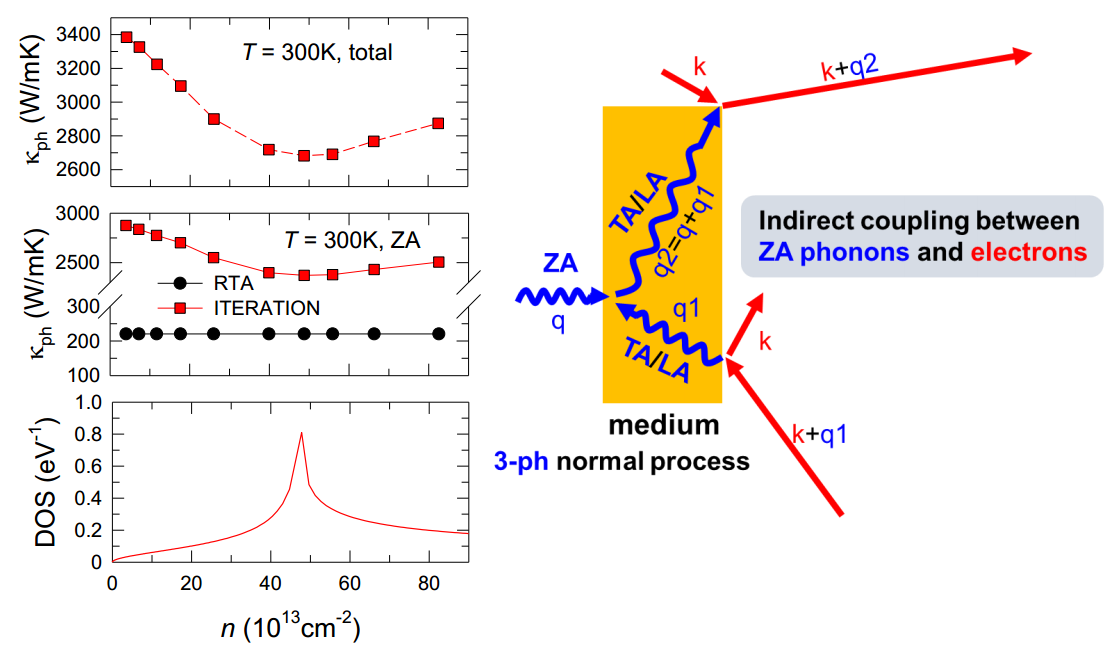Thermal conductivity is an important property of materials. Graphene has a record-high lattice thermal conductivity, namely ~ 4000 W/mK at room temperature. The manipulation of its thermal conductivity is of great importance not only from the fundamental point of view but also from practical applications. Despite intensive study of thermal transport in graphene, the effect of electron-phonon interaction (EPI) on its thermal conductivity, however, has never been studied. This is because it was long believed that EPI can affect phonon transport only at very low temperatures.
Only recently it was found that the EPI can play a significant role in lattice thermal conductivity in certain materials even at room temperature. For instance, Li Wu's group found that in elemental W, strong interatomic bonding and the body-centered cubic structure cause the weak phonon-phonon scattering to be dominated over by the phonon-electron scattering, leading to 80% reduction in lattice thermal conductivity and its weak temperature dependence [ Phys. Rev. B 99, 020305 (Rapid Communication) (2019); npj Comput. Mater. 5, 98 (2019) https://ias.szu.edu.cn/info/1019/4475.htm]. Besides, it was also found that phonon-electron scattering dominates over the phonon-phonon scattering also in some transition metal carbides (TMDs) [Phys. Rev. Lett. 121, 175901 (2018)]. Recently Prof. Li Wu's group revealed the origin of the anomalous phonon transport behaviors of TMDs in the electronic structure [Materials Today Physics 13, 100214 (2020) https://ias.szu.edu.cn/info/1019/5344.htm]. As for the case of graphene, since the flexural acoustic (ZA) phonons, the dominant carriers of thermal conductivity, do not interact with electrons directly due to the reflection symmetry [Phys. Rev. B 93, 155413 (2016)], the EPI is thus expected to have no effect on its thermal conductivity.
Recently, Li Wu's group investigated the effect of EPI on the lattice thermal conductivity of graphene by performing first-principles calculations. Strikingly, they identified an “indirect electron-phonon scattering” mechanism for the first time. Although the ZA phonons cannot be scattered by electrons directly, their indirect interaction with electrons mediated by the in-plane transverse acoustic (TA) and longitudinal acoustic (LA) phonons can result in ∼21% reduction of lattice thermal conductivity even at room temperature. This indirect EPI is due to the predominance of normal three-phonon processes over Umklapp processes. Such an indirect effect should also exist widely in many other two-dimensional materials including single-layer BN, BAs, and thin graphite, whose intrinsic lattice thermal conductivities are dominated by normal processes. Furthermore, they found that the reduction in thermal conductivity does not increase monotonically with charge carrier density, and thermal conductivity can be minimized at an optimal carrier density, which is strongly correlated to the electron density of states at corresponding Fermi levels.

(Figure: On the left is phonon thermal conductivity (total thermal conductivity, ZA's contribution to thermal conductivity), and electron state density as a function of charge density; On the right is a diagram for indirect electron-phonon scattering between ZA phonons and electrons.)
This work was published in Materials Today Physics XX, 100315 (2020), entitled "Indirect electron-phonon interaction leading to significant reduction of thermal conductivity in graphene ". The first author of the paper is Dr. Yang Xiaolong, and collaborators include Prof. Li Xiaoguang, Dr. Ma Jinlong (now working at Huazhong University of Science and Technology), Dr. Ajit Jena (former postdoctoral fellow in Prof. Li Wu's group), Dr. Meng Fanchen, (now working at Clemson University), and Mr. Wen Shihao. The research was supported by the National Natural Science Foundation of China, China Postdoctoral Science Foundation, and Shenzhen Science and Technology Commission.
Prof. Li Wu has been engaged in the research of phonon transport since 2008. He has developed the open-source software ShengBTE with collaborators (cited by more than 980 times and widely used by hundreds of research groups around the world), which makes the parameter-free first-principles techniques become the mainstream.
Paper link:
https://www.sciencedirect.com/science/article/pii/S2542529320301395#undfig1


